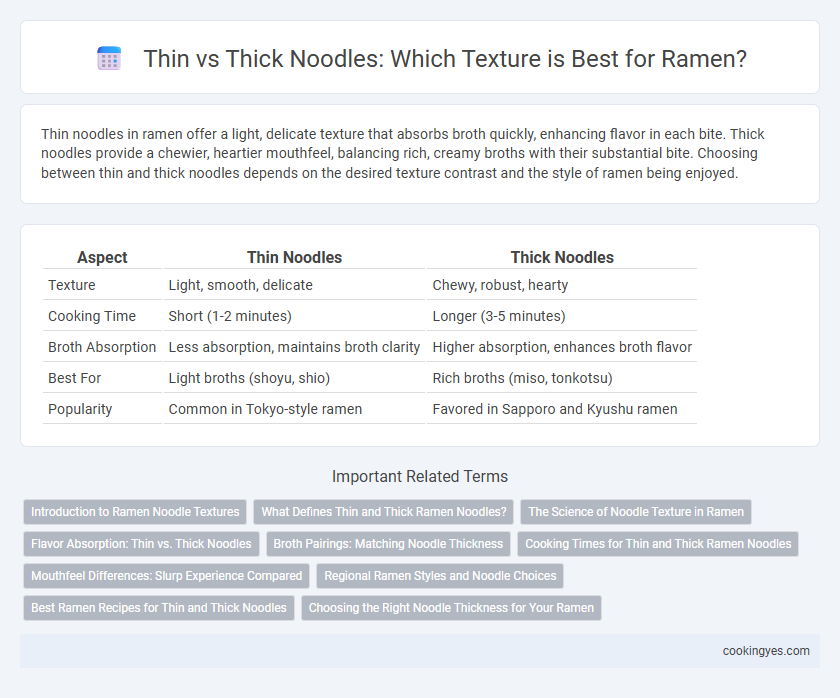Thin noodles in ramen offer a light, delicate texture that absorbs broth quickly, enhancing flavor in each bite. Thick noodles provide a chewier, heartier mouthfeel, balancing rich, creamy broths with their substantial bite. Choosing between thin and thick noodles depends on the desired texture contrast and the style of ramen being enjoyed.
Table of Comparison
| Aspect | Thin Noodles | Thick Noodles |
|---|---|---|
| Texture | Light, smooth, delicate | Chewy, robust, hearty |
| Cooking Time | Short (1-2 minutes) | Longer (3-5 minutes) |
| Broth Absorption | Less absorption, maintains broth clarity | Higher absorption, enhances broth flavor |
| Best For | Light broths (shoyu, shio) | Rich broths (miso, tonkotsu) |
| Popularity | Common in Tokyo-style ramen | Favored in Sapporo and Kyushu ramen |
Introduction to Ramen Noodle Textures
Thin noodles in ramen offer a light, firm texture that quickly absorbs broth, enhancing flavor with each bite. Thick noodles provide a chewy, hearty consistency that complements rich, dense broths, balancing the overall mouthfeel. Selecting noodle thickness directly influences the ramen's texture profile and culinary experience.
What Defines Thin and Thick Ramen Noodles?
Thin ramen noodles typically measure around 1.1 to 1.3 millimeters in diameter, resulting in a firmer, springier texture that absorbs broth quickly, enhancing flavor intensity. Thick ramen noodles, often exceeding 1.8 millimeters, offer a chewier, more substantial bite and hold up well in richer, heavier broths like miso or tonkotsu. The noodle thickness directly influences mouthfeel and broth interaction, defining the overall ramen eating experience.
The Science of Noodle Texture in Ramen
Thin noodles in ramen absorb broth quickly, enhancing flavor infusion and creating a smooth, slippery texture ideal for light, clear soups like shoyu or shio ramen. Thick noodles have a denser structure, offering a chewy, firm bite that holds up well in rich, heavy broths such as tonkotsu or miso, providing a satisfying contrast. The starch composition and water content during noodle making critically influence elasticity and mouthfeel, directly impacting the overall sensory experience of ramen.
Flavor Absorption: Thin vs. Thick Noodles
Thin ramen noodles excel at flavor absorption due to their increased surface area and porous texture, allowing broth and seasonings to cling effectively. Thick noodles offer a chewier bite with a denser structure that absorbs less broth but delivers a robust mouthfeel. Choosing between thin and thick noodles impacts the balance between flavor intensity and textural satisfaction in ramen.
Broth Pairings: Matching Noodle Thickness
Thin ramen noodles absorb lighter broths like shoyu or shio, enhancing the broth's subtle flavors without overpowering the texture. Thick noodles provide a chewy bite that pairs well with rich, hearty broths such as miso or tonkotsu, ensuring a balanced mouthfeel. Choosing the right noodle thickness is crucial to complement and elevate the overall ramen experience through texture and flavor harmony.
Cooking Times for Thin and Thick Ramen Noodles
Thin ramen noodles cook quickly, often within 1 to 2 minutes, resulting in a firm yet tender texture that absorbs broth flavors efficiently. Thick ramen noodles require longer cooking times, typically around 3 to 5 minutes, to achieve a chewy and hearty bite that holds up well to rich, heavy soups. Precise timing ensures the ideal balance between noodle texture and soup integration, enhancing the overall ramen experience.
Mouthfeel Differences: Slurp Experience Compared
Thin ramen noodles offer a delicate, springy texture that allows broth flavors to coat each strand evenly, creating a light, smooth mouthfeel ideal for quick slurping. Thick noodles provide a chewier, more substantial bite, enhancing the broth's richness and delivering a heartier, more satisfying slurp experience. The contrast in noodle thickness directly influences how broth is absorbed and the overall sensory engagement during eating.
Regional Ramen Styles and Noodle Choices
Regional ramen styles showcase a clear preference in noodle thickness to complement local broth flavors, with thin noodles favored in Hakata-style tonkotsu ramen for their quick cooking and firm texture that balances rich, creamy broth. In contrast, thick noodles are prevalent in Sapporo-style miso ramen, offering a chewy bite that holds up well against the hearty, robust miso base. These noodle choices enhance the overall texture and flavor harmony unique to each regional ramen tradition.
Best Ramen Recipes for Thin and Thick Noodles
Thin noodles in ramen offer a light, delicate texture that absorbs broth flavors quickly, making them ideal for clear, soy-based or shoyu ramen recipes. Thick noodles provide a chewy, hearty bite that holds up well in rich, creamy tonkotsu or miso broths, enhancing the overall mouthfeel. Best ramen recipes optimize noodle thickness to complement broth density, balancing texture and taste for an authentic experience.
Choosing the Right Noodle Thickness for Your Ramen
Thin noodles in ramen offer a delicate, smooth texture that absorbs broth flavors quickly, ideal for light, clear soups like shoyu or shio ramen. Thick noodles provide a chewy, hearty bite that holds up well in rich, robust broths such as miso or tonkotsu, enhancing the overall mouthfeel. Selecting the right noodle thickness depends on the broth's intensity and the desired textural balance to create a harmonious ramen experience.
Thin noodles vs Thick noodles for ramen texture Infographic

 cookingyes.com
cookingyes.com